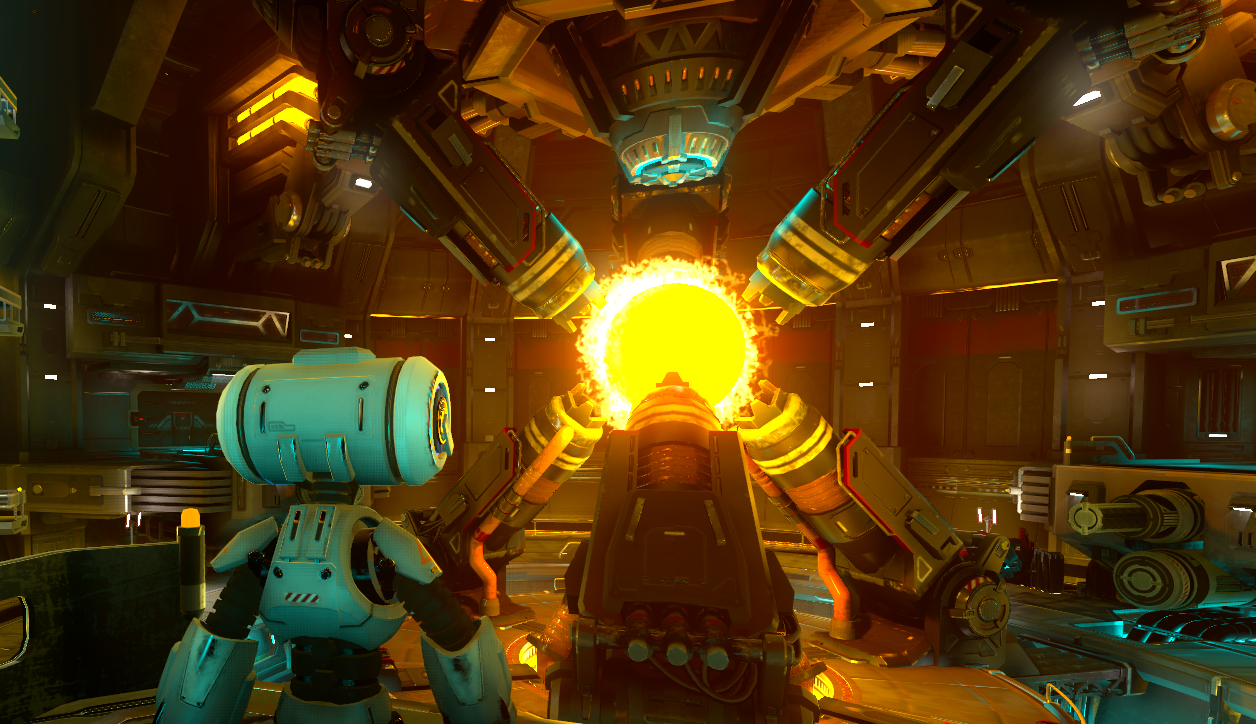
Godot 3.3 has arrived, with a focus on optimization and reliability
By: Rémi Verschelde 21 April 2021
All Godot contributors are delighted to release our latest milestone today, Godot 3.3, after more than 7 months of development! This release was initially planned as a 3.2.4 update to the 3.2 branch, but it grew to become a feature-packed update well worth of opening a new stable branch.
While most development focus is on our upcoming Godot 4.0 release, many contributors and users want a robust and mature 3.x branch to develop and publish their games today, so it's important for us to keep giving Godot 3 users an improved gamedev experience. As such, most of the focus was on implementing missing features or bugfixes which are critical for publishing 2D and 3D games with Godot 3, and on making the existing featuresmore optimized and reliable.
Godot 3.3 is compatible with Godot 3.2.x and is a recommended upgrade for all 3.2.x users.
Download Godot 3.3 now and read on to learn more about our versioning update, our plans for support, and of course the many new features in this update.
Versioning change
When we released Godot 3.2 in January 2020, we switched the development focus towards the upcoming Godot 4.0, which is a major, compatibility-breaking rewrite of the engine's core and rendering.
We knew this would take a while, so we decided to make the 3.2 branch a long-term support branch, which would receive 3.2.x updates with bug fixes, but also new features as long as they don't require breaking compatibility. This led us to have a quite feature-packed 3.2.2 release, and for over 6 months we'd been working on another feature-heavy 3.2.4 milestone.
Along the way, we realized that our versioning scheme was too confusing and limiting, and that it could benefit from a change. So what was planned to be Godot 3.2.4 has been renamed to 3.3, and this is the release we're publishing today.
As such, Godot 3.3 is fully compatible with Godot 3.2.x (like you'd expect from a release named 3.2.4) and is a recommended upgrade for all users.
This rename also means that no new release will happen in the 3.2 branch. The 3.2 branch on Git has been reset to the 3.2.3-stable state, since all subsequent work done in that branch is now part of the 3.3 branch.
Long-term support for 3.x
Since we renamed 3.2.4 to 3.3, thus opening up a new stable branch, how does this impact our plans for long-term support while Godot 4.0 is being worked on?
We've updated our release policy to better reflect our intention to follow Semantic Versioning, and the support expectations for each branch.
Like 3.0 before it, the upcoming Godot 4.0 release will be a significant change in the Godot ecosystem, and we expect that users will keep using Godot 3.x for a while, until Godot 4.x is stable enough and works reliably on all hardware.
So we've reopened a development branch for 3.x releases, which was used to develop this version 3.3. We'll now use it to develop Godot 3.4, which will be another feature release that aims at being compatible with older Godot 3.x versions (and will only contain some compatible changes backported from the in-development 4.0 version).
We don't have an ETA for 3.4 yet, but we're aiming for shorter release cycles for upcoming 3.x releases, now that we have a fairly mature base to build upon.
We intend to keep supporting the 3.x branch with minor releases (3.4, 3.5, etc.) as long as we have both users and contributors interested in such updates. There will likely be a time of overlap after Godot 4.0 is released where we still work on 3.x updates in parallel, like we did with Godot 2.1 and 3.x.
For stable branches (e.g. 3.3.x), we're going back to a stricter application of semantic versioning and those releases will only contain bug fixes and usability/documentation improvements. This should make them risk-free updates for all users.
All new feature work for Godot 3 will go in the 3.x branch for the next minor release (e.g. 3.4). This will enable us to publish maintenance updates at a faster pace as soon as we identify a need (critical regressions to fix, security issues, necessary platform updates, etc.). So you can expect Godot 3.3.1 in the coming weeks with a first batch of fixes.
Supporting the project
Godot is a not-for-profit organization dedicated to providing the world with the best possible free and open source game technology. Donations and corporate grants play a vital role in enabling us to develop Godot at this sustained pace, since they are our only source of income, and are used 100% to pay developers to work on the engine. Thanks to all of you patrons from the bottom of our hearts!
If you use and enjoy Godot, plan to use it, or want support the cause of having a mature, high quality free and open source game engine, then please consider becoming our patron. If you represent a company and want to let our vast community know that you support our cause, then please consider becoming our sponsor. Additional funding will enable us to hire more core developers to work full-time on the engine, and thus further improve its development pace and stability.
Features
After this long introduction, time to have a look at the many new features included in Godot 3.3!
There have been thousands of changes, big and small, so listing everything would be impossible. You can however consult the detailed changelog, where we attempted to list most relevant changes, separated by category: additions, changes, removals, and fixes. Note that this is a changelog between 3.2.3-stable and 3.3-stable. If you want to know all changes compared to 3.2-stable, you should also consider the intermediate 3.2.x changelogs.
In the rest of this post, we aim to give a broad overview of the most noteworthy features and changes in Godot 3.2. You can read in order, or use the index below to jump to your areas of interest.
Again, this is not an exhaustive list of changes in this release, so we advise interested users to also dive into the detailed changelog to know more.
Platforms
Godot editor on the Web!
Fabio Alessandrelli (faless) has done a lot of work to enable running the Godot editor on the Web, using the same export code as for Godot-made games (since the Godot editor is developed 100% with the Godot API). These changes have led to countless improvements for Web exports (see below).
Building upon the initial prototype, we've now reached a state where we're happy to release the Web editor in sync with the native version, so you can find the latest stable version on editor.godotengine.org.
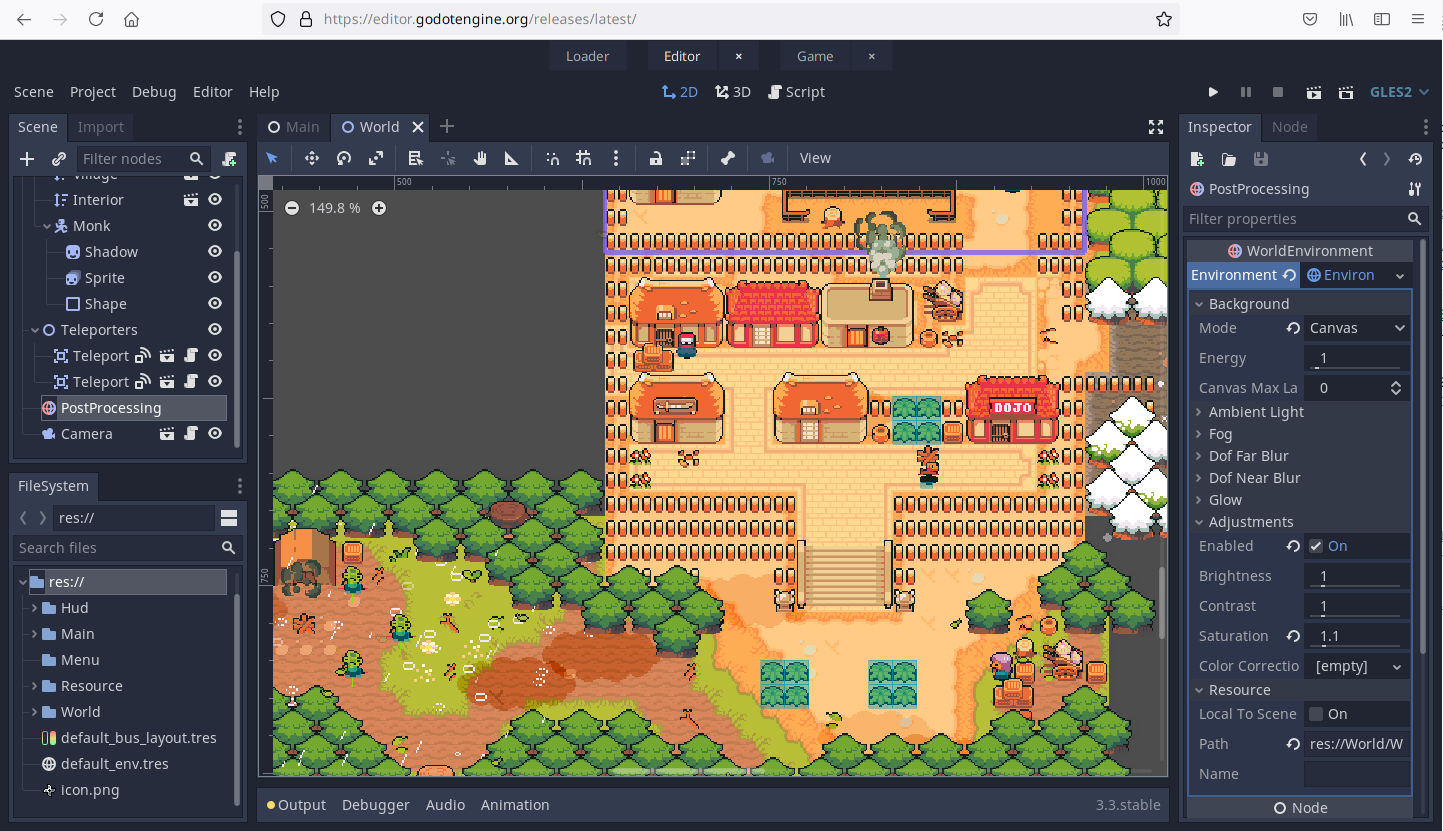 Web editor running the "Ninja Adventure" demo from the eponymous CC0 asset pack by Pixel-Boy and AAA.
Web editor running the "Ninja Adventure" demo from the eponymous CC0 asset pack by Pixel-Boy and AAA.
See Fabio's various progress reports to know more about the rationale, use case and implementation details: first prototype, second prototype, beta version, release candidate, Progressive Web App.
Android: App Bundle, subview, signing
Android App Bundle (AAB) is a publishing format that enables more efficient distribution of Android apps. Thanks to Aman Jain (amanj120) and the support of our Android maintainer Fredia Huya-Kouadio (m4gr3d), Godot 3.3 now supports exporting AABs in addition to APKs.
Google Play recommends publishing AABs since they enable the Play Store to distribute only the preferred native libraries for the ABI of a device, e.g. only armeabi-v7a or arm64-v8a. In the second half of 2021 AABs will become the only supported publishing format for Google Play.
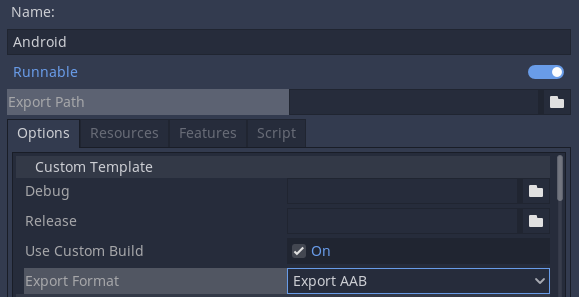
Additionally, many other features have been implemented such as subview embedding, support for cutout/notches on Android 9+, and implementation of mouse events and external keyboard input.
To accommodate Google Play requirements, we disable the requestLegacyExternalStorage attribute when there are no external storage permissions enabled. Note that if you do need access to external storage, Godot will currently still need to set this attribute as support for scoped storage hasn't been implemented yet.
Similarly, we've updated the signing logic to use apksigner instead of the now deprecated jarsigner. This requires you to review your Android SDK setup and editor settings to make sure that Godot can find apksigner in a compatible version. See Exporting for Android for the updated documentation.
iOS: New plugin API
Godot 3.2.2 introduced a new API for Android plugins which allow building and distributing them easily to end users.
For 3.3, Sergey Minakov implemented the same interface for iOS plugins. This made it possible to move iOS plugins such as ARKit, GameCenter, InAppStore, etc. to a separate, first-party godot-ios-plugins repository, so they can be improved independently of Godot itself.
And the same can be done for third-party plugins which can now be distributed as convenient plug-and-play packages. See iOS plugins for the relevant documentation on creating and using such plugins.
HTML5: Threads, GDNative, AudioWorklet
In parallel to working on the Web editor, Fabio did many improvements to the HTML5 platform port which will benefit all users.
One notable change is that there is now support for both threads and GDNative in the HTML5 platform port. However, due to platform limitations, those are mutually incompatible. Additionally, the threads support depends on the SharedArrayBuffer API, which is not yet supported in all browsers (notably Safari on macOS and iOS). As such Godot 3.3 comes with three different export templates, see Exporting for the Web for detailed documentation.
The "threads" build additionally benefits from support for the AudioWorklet API, which allows better audio output without blocking the main thread.
Fabio also greatly improved support for gamepads and virtual keyboards in the Web export... and tons of other things which would be impossible to mention exhaustively here. But in short, 3.3 is a massive release for the Web export.
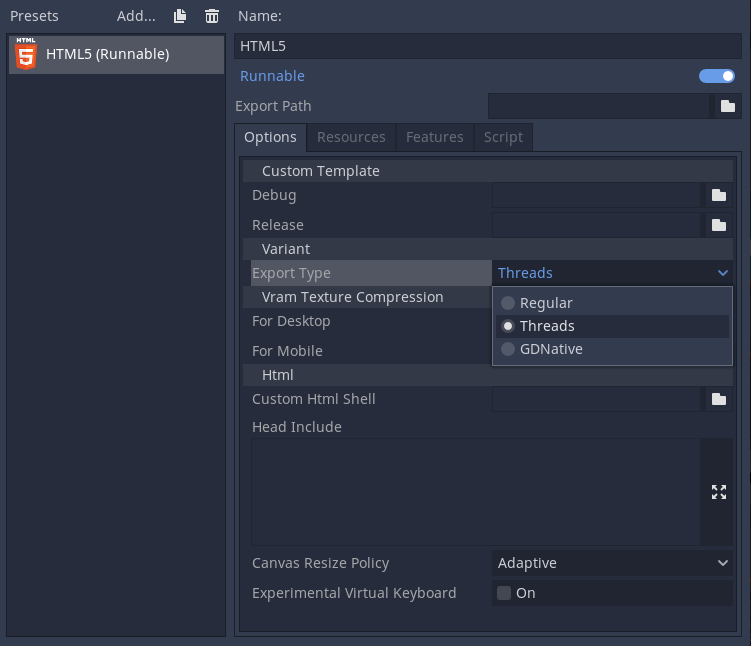
macOS: ARM64 build, code signing
Thanks to Pāvels Nadtočajevs (bruvzg), Godot 3.2.3 already had support for compiling Godot for Apple M1 Macs (ARM64 architecture), but we hadn't updated our infrastructure to provide such builds at the time. With Godot 3.3, we now provide a universal binary which supports both x86_64 and ARM64 Macs. As of 3.3, this is only for the standard build, not for the Mono ones, as we still need more work to be able to cross-compile Mono for Apple M1.
Additionally, we now provide editor binaries which are signed and notarized, so you should no longer need to jump through hoops to run Godot on a Mac. Thanks to Hein-Pieter van Braam-Stewart (hpvb) and his company Prehensile Tales who provide the Mac and signing certificate needed for this. Both standard and Mono builds are notarized.
The export dialog now has support for signing your builds when you export your game from a Mac, including the configuration of entitlements (this is sadly not possible from other OSes as it depends on macOS-specific tools).
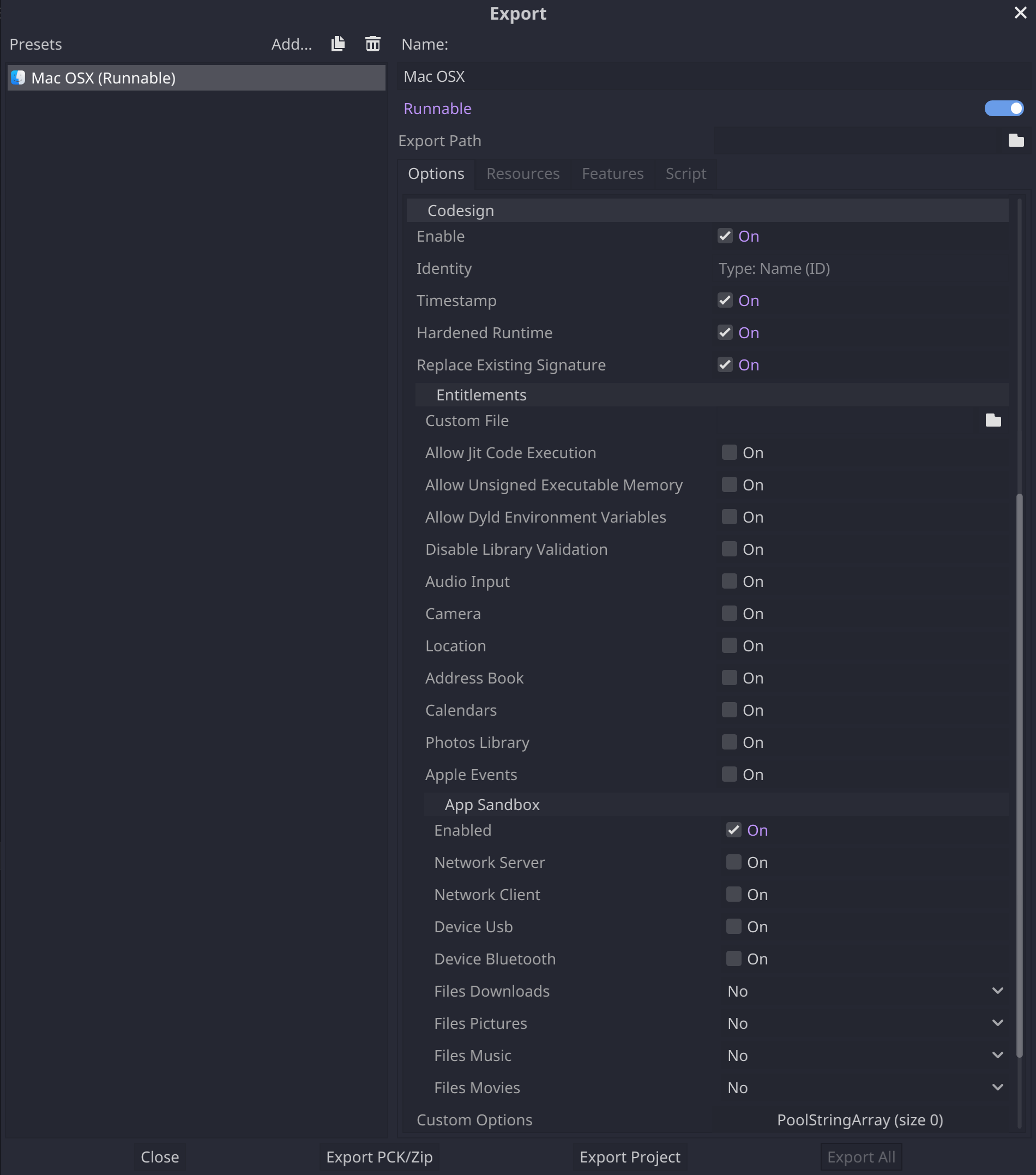
Core
Modernized multi-threading APIs
After doing this work for the master branch (4.0), Pedro J. Estébanez (RandomShaper) backported his modernization of multi-threading APIs to the 3.x branch. This builds upon Godot's recent adoption of C++11 and beyond (now C++17 in the master branch, C++14 in 3.x), which provides us with more reliable cross-platform implementations than the ones we had so far.
This should help fix some issues which could affect specific platforms, as well as improve overall reliability and performance. It is however a fairly major change so if your projects relied heavily on multi-threading APIs and you encounter any issue with 3.3, please make sure to report it.
Dynamic BVH for rendering and GodotPhysics
Our contributor lawnjelly seems to have decided to tackle many much needed optimizations for the 3.x branch, to ease our waiting time for Godot 4.0. One such optimization was the implementation of a dynamic BVH method for spatial partitioning as an alternative to Godot's existing Octree. This aims at solving many performance issues and bugs of the octree implementation, and benefits the rendering and GodotPhysics backends specifically (Bullet already has its own BVH).
The new BVH is used by default, but there are project settings to change that and go back to the octree method if you notice issues in your project. Make sure to report any problem you encounter on GitHub, so that we can keep improving this for Godot 3.4.
Raise errors when accessing deleted objects in debug
Most Godot users are familiar with the infamous situation of attempting to access a reference to an Object after it has been freed. The reference does not evaluate to null, yet it can't be safely dereferenced, leading to the risk of crashes in release builds if such dereferencing is not verified with is_instance_valid(). There were several fixes around this in 3.2.2, and some follow-ups in 3.2.3 but going one step too far: in debug builds in 3.2.3, such references to freed objects would evaluation as null, thus leading to tricky situations where a game runs fine in the editor (debug) but would error out or crash once exported in release mode.
Godot 3.3 solves this by no longer decaying references to freed objects to null in debug builds, so you should properly get errors in the editor that let you identify which code is problematic.
Rendering
Unified 2D batching
After implementing 2D batching in GLES2 in 3.2.2 and 3.2.3, lawnjelly has overhauled the system with a common intermediate layer allowing it to operate in GLES3 as well as GLES2. In addition batching has been expanded to cover many other primitives (polys, lines, ninepatches) as well as the rects featured in earlier versions.
New vertex formats allow many more custom shaders and cases to take advantage of batching than before, and optional 2D software skinning has been added which should allow using 2D skeletal animation on a far wider range of hardware than was previously available.
As always, it is possible to revert to the legacy renderer by turning off batching in project settings.
New CPU lightmapper
The lightmapper in the previous 3.x releases was quickly put together before the 3.0 release and it had some major issues. It was reusing parts of the code for baking GIProbes, and that made it quick but not great in terms of quality. Back in summer 2019 we already knew Godot 4.0 would feature a completely new GPU-based lightmapper, but it required Vulkan support and 4.0 was still far away, so we tasked Joan Fons (jfons), as part of the GSoC program, to write a new CPU lightmapper for Godot 3.x. After a long hiatus in development and a couple of rewrites here and there, the brand new CPU lightmapper was finally merged into the 3.3 branch at the begining of this year.
The biggest difference with the old lightmapper is that the new one features proper path tracing, which results in better looking lightmaps. Also, the new lightmapper brings support for denoising using Open Image Denoise, which results in better-looking lightmaps in the same bake time range. On top of that, other quality of life improvements have been added or back-ported from 4.0, such as support for baking environment lighting, lightmap texture atlassing, per-object resolution scaling, cubic filtering of lightmaps at runtime, and last but not least, automatic disabling of baked lights, which eases up the pain of mixing baked and non-baked objects and light in the same scene.
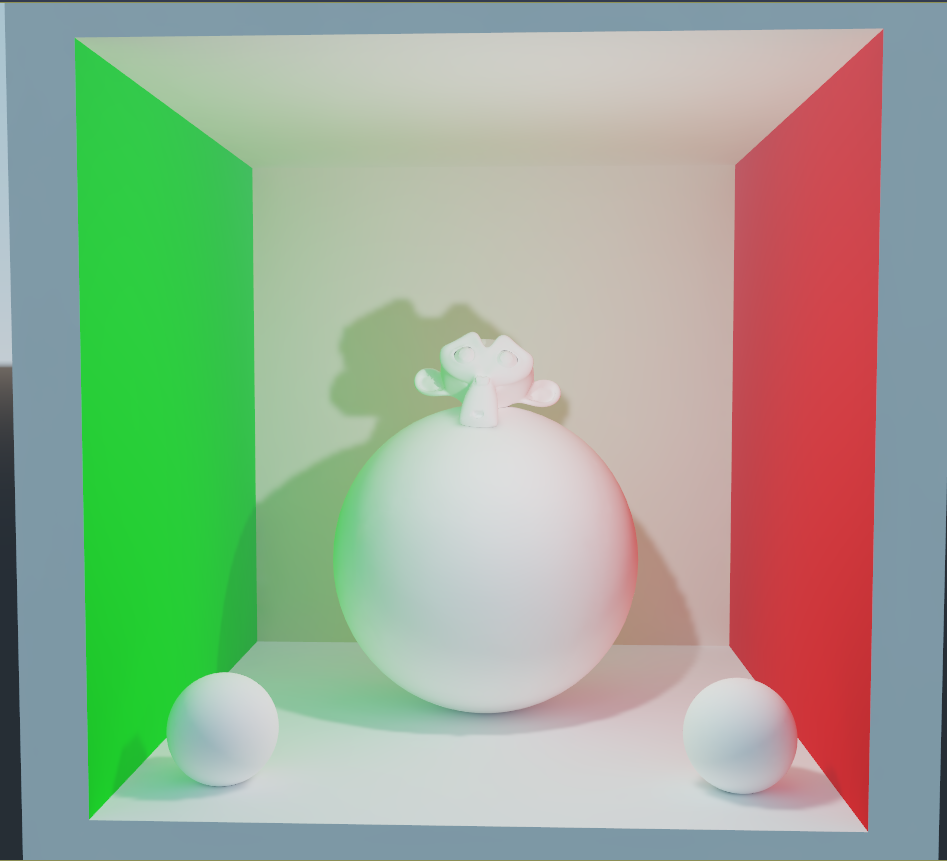
More rendering improvements
While there's so much rendering work being done for Godot 4.0, the 3.3 release got its fair share of improvements, thanks to the dedicated of contributors such as lawnjelly, Clay John (clayjohn), Joan, Hugo Locurcio (Calinou), Camille Mohr-Daurat (pouleyKetchoupp), NHodgesVFX, and more!
Some examples are:
Better soft shadows in the low-end GLES2 renderer.
Physics
Many fixes to one-way collisions
This has been a long-term undertaking involving multiple PRs from multiple contributors, and a number of additional testers and reviewers, so kudos to them: Marcel Admiraal (madmiraal), Camille, bemyak, Rhathe, and more!
One-way collisions prior to Godot 3.3 had many issues, some known for years but this code had the tendency to regress whenever a given issue got fixed. To solve this, in addition to some excellent debugging and bug fixing effort, Marcel and Camille designed thorough test cases so that the fixes could be validated in a number of different situations. The end result is a lot more reliable, though there are still a number of known issues which will require more fixes and more test cases to be fully ironed out.
Fixes to KinematicBody collisions
Camille, Marcel and Juan did significant work on long-standing issues with the reliability of KinematicBody collisions. One of the main changes merged for 3.3 is a change to KinematicBody's recovery after being stuck in a collider, affecting methods such as move_and_slide() or move_and_collide().
As physics code is fairly sensitive and prone to regressions when trying to fix a given edge case, Camille made extensive physics test projects for 2D and for 3D, to help validate changes and prevent further regressions.
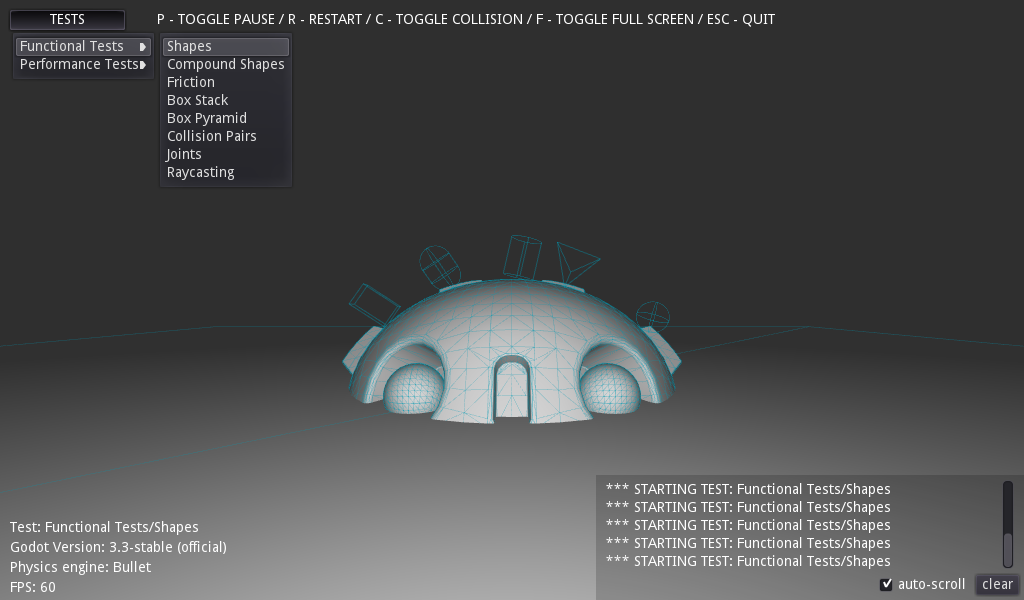
Here too, there are still a number of known issues to address, and this will be one of Camille's main focus areas for 4.0 in coming months. Many of the upcoming bug fixes will likely be backported to the 3.x branch for future releases (e.g. 3.4).
Cylinder collision shape for GodotPhysics
As part of his Godot 4.0 work, Camille is implementing missing features in the GodotPhysics 3D backend to reach feature parity with Bullet. One of these was the support for Cylinder collision shapes, which has been implemented for Godot 4.0 and backported to 3.3. This is an experimental feature as of 3.3, as it hasn't received extensive testing yet and there are some known bugs in edge cases, so you can expect further fixes in Godot 3.4.
Editor
Node copy-pasting
Being able to easily cut/copy and paste nodes sounds like a basic feature to have, but it is only now that it could finally be implemented in a reliable way, thanks to the hard work of Tomasz Chabora (KoBeWi). Previously, to copy nodes within the scene, they had to be duplicated and dragged under the desired parent. Moving nodes between scenes was only possible by using the clunky "Merge from scene" feature. Being able to copy nodes as easily as you can copy text was probably one of the most-wanted features since the first release of Godot!
There were multiple attempts at implementing it, but it took time to refine them into someting reliable that could be merged, especially due to the need to take into account the full complexity of the scene tree (instanced scenes, editable children, shared or unique resources and subresources, etc.). In Godot 3.3, the dream has come true: nodes can be cut, copied and pasted, both within the same scene and between scenes. Manipulating the scene tree has never been this convenient.
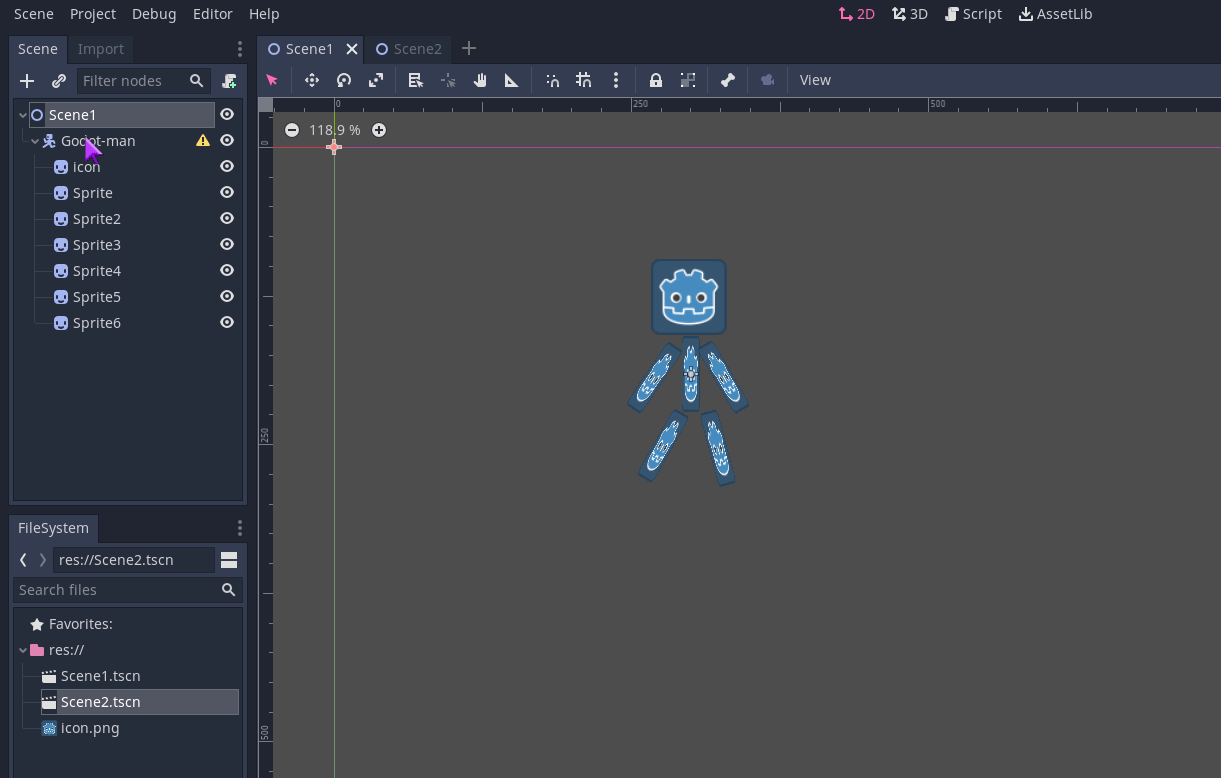
Hello again, logo.png stickman!
Improved Inspector sub-resource editing
After much discussion, Juan Linietsky (reduz) implemented a change to the Inspector to better highlight sub-resources visually, so that it's easier to know which resource you're editing when there are more than two levels.
This was implemented for Godot 4.0 but was fairly easy to backport, so here you go! The colors and contrast can be customized in the editor settings.

Import presets configuration
When you add assets to a Godot project, most of them get imported to engine internal formats on the fly based on options configured in the Import dock. There are some pre-existing presets for all asset types, and you can define which preset should be used for all resources of the same type (e.g. "2D Pixel" preset for textures), but until there was no easy way to configure all presets easily in a unified interface.
For Godot 4.0, Juan implemented a new tab in the Project Settings dialog to configure those "Import Defaults", and this was backported to Godot 3.3.
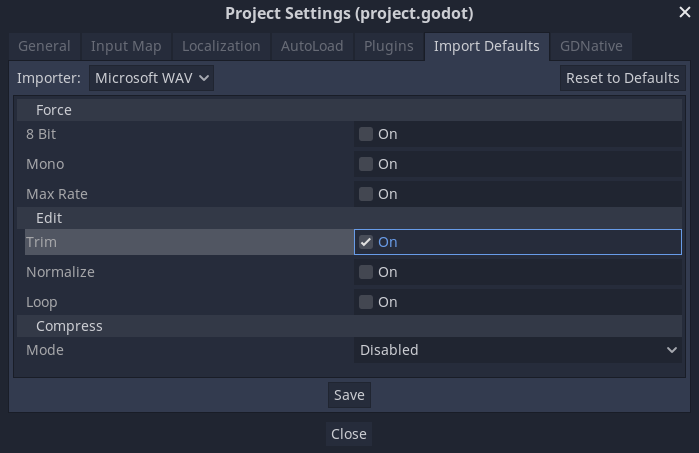
Additionally, a new "Keep" import mode was added to configure specific files to be left as-is (i.e. not imported) by Godot's import system. This is particularly useful for files which you intend to process yourself from scripts based on their raw contents (e.g. using the File API, loading it as text or bytes), such as CSV files used as database (as opposed to Godot's default CSV import preset as translation catalogs).
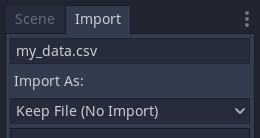
3D editor improvements
Contributors such as Aaron Franke (aaronfranke), Joan and Hugo did a significant amount of work improving the usability of the 3D editor for 4.0, and most of it was backported to the 3.3 branch. This includes changes such as:
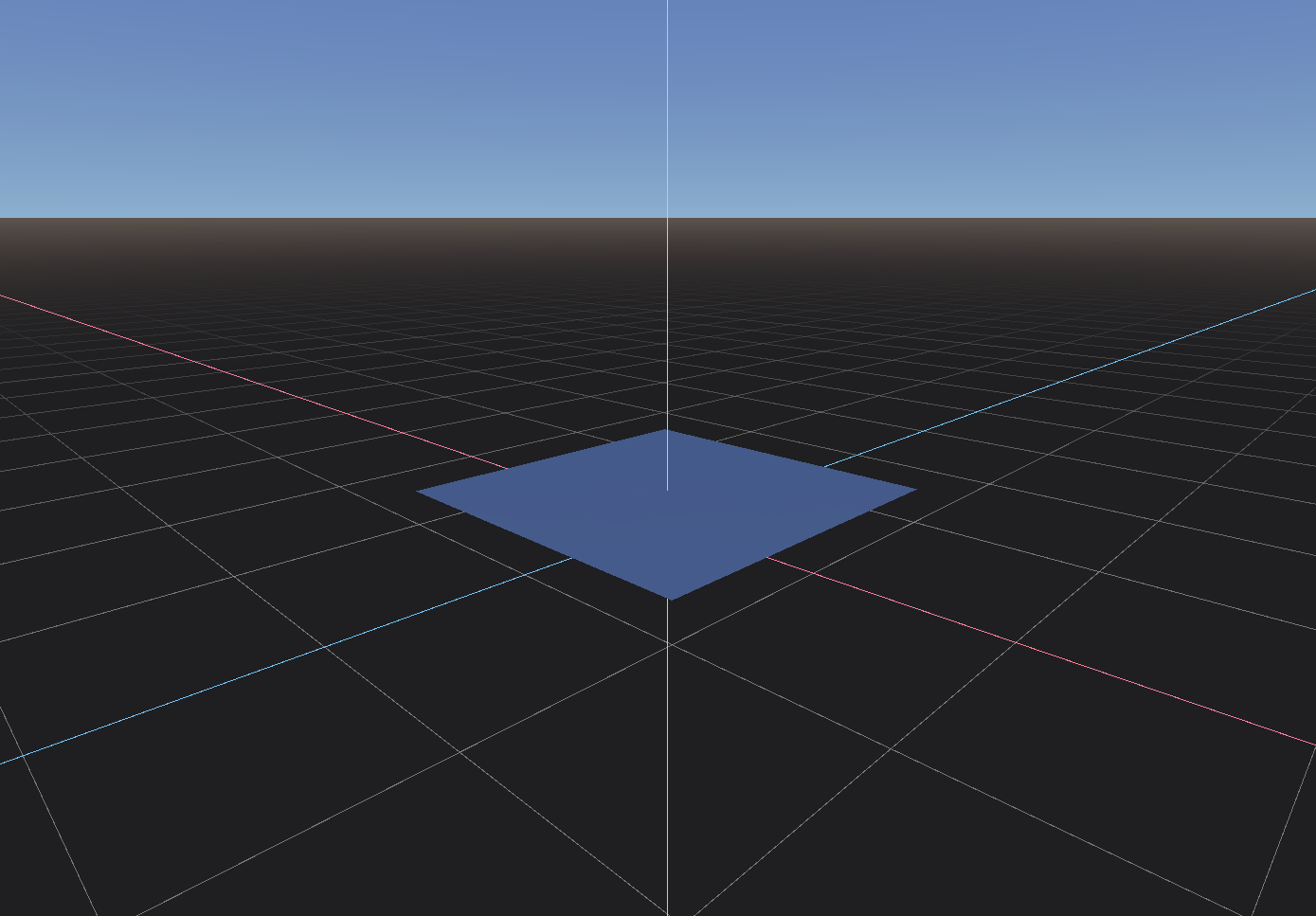
To infinity and beyond!
Detect external scene changes
One of the biggest hurdles when working with Godot projects in a team was that it's very easy to overwrite changes made by another person if they modified a currently opened scene. How often did you pull changes from Git to only see them discarded, because Godot didn't detect that the scene had changed? While with scenes you just had to reload them, modifications to project.godot by another team member required you to restart the Godot editor to properly apply changes. This was especially problematic during game jams where multiple people work on the same small project simultaneously.
Thanks to Tomasz again, with Godot 3.3, any external changes to opened scenes or project.godot, be it VCS pull or external text editor modification, are properly detected by the Godot editor and you get an option to either reload the affected files, discard the changes or do nothing (which in most cases means another prompt when the editor is re-focused).
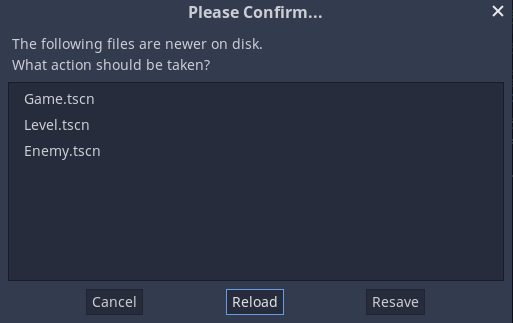
Do note that due to how built-in resources (resources saved within the scene instead of separate files) work, some of them might sometimes not get reloaded correctly (this especially applies to built-in scripts). It's a known infrequent issue, already fixed in Godot 4.0.
Scripting
GDScript
No big change for GDScript in this release as all the focus has been on the rewrite and optimization of GDScript for Godot 4.0. Still, there's been a number of bugfixes which should make the experience more stable.
As for eye candy, Yuri Roubinsky (Chaosus) implemented a feature to preview Color constants in the auto-completion drop-down:
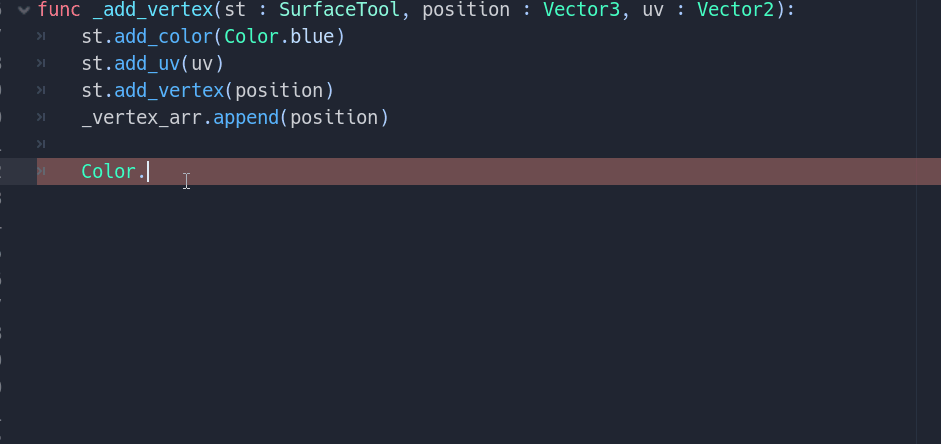
Mono/C#
C# users will benefit from a redesign of the solution build output panel made by Ignacio Roldán Etcheverry (neikeq):

There have been further fixes to the solution and build system, allowing users to target .NETFramework with the Godot.NET.Sdk and .NET 5. Moreover a 3.2.2 regression was fixed for System.Collections.Generic.List marshalling, and Unicode identifiers are now properly supported.
There's also been extensive work on Mono compatibility with WebAssembly.
Other areas
Improved FBX importer
Gordon MacPherson (RevoluPowered) rewrote the prototypical Assimp-based FBX importer that we had in Godot 3.2 to support a lot of the more advanced features used in professional FBX-based workflows. You can read his devblog about it for details.
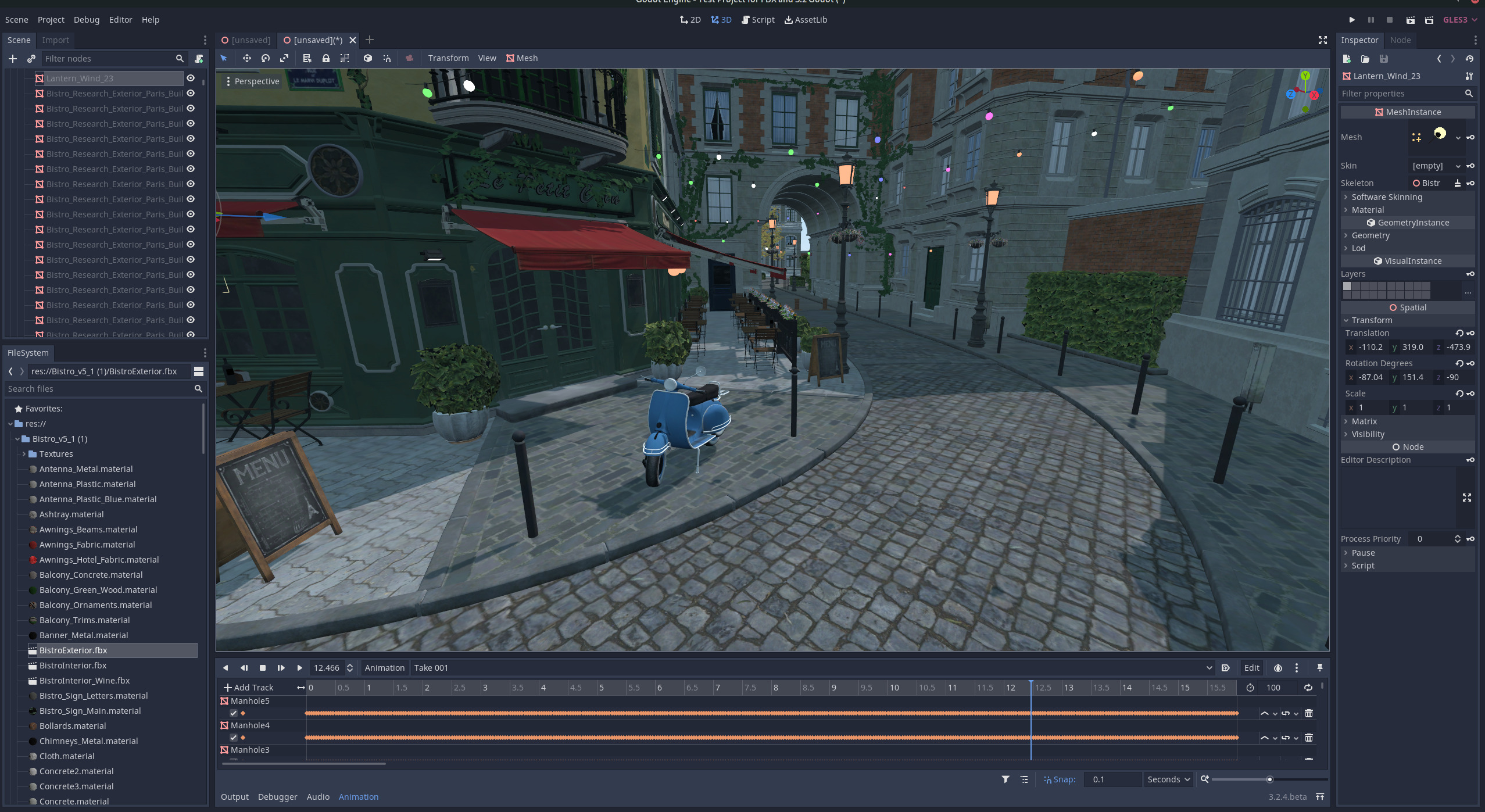
In the current state, the new importer works quite well for FBX assets authored in Autodesk Maya. There are known issues with some other types of FBX models which are currently being addressed, and should be fixed in upcoming 3.x (and possibly 3.3.x) releases. If you have models that fail to import properly, please file a bug report so that we can investigate and solve it.
WebXR support for VR games
VR developers got a nice surprise back in September when David Snopek (dsnopek) landed a pull request to implement WebXR support in Godot's HTML5 port. Since it was merged earlier this year, we've seen a number of prototypes being developed with 3.3 RC builds' WebXR support, and we're eager to see what the community will create now that it's available in a stable release!
David's talk about WebXR support at Online GodotCon in January 2021.
OpenXR plugin
As one of his first tasks as a new full-time developer, Bastiaan Olij (BastiaanOlij) worked on an OpenXR plugin for Godot 3.3, before focusing on rendering optimization for mobile Vulkan in the 4.0 branch. He built on the pre-existing effort by Christoph Haag (ChristophHaag), porting the Linux-only plugin to Windows, and implementing a first version of the the OpenXR action system. You can read more in this devblog.
You can download the GDNative plugin directly from its GitHub repository.
MP3 loading and playback
We initially avoided the ubiquitous MP3 audio format for two reasons: it was patent encumbered, and less performant than alternatives like OGG Vorbis. Since the patents expired, and a good minimal open source implementation is available (minimp3), we finally decided to include MP3 support in the engine. This was implemented by DeleteSystem32.
It is still not recommended for audio streams as OGG Vorbis is typically better, but it enables Godot projects to load pre-existing MP3 assets that they can't convert beforehand: assets streamed from the Internet, or loaded by the users from their system. So supporting the ubiquitous MP3 format with a tiny library ends up being quite useful.
New AspectRatioContainer Control node
Making dynamic UI with containers while keeping control of aspect ratio has been made very easy thanks to the new AspectRatioContainer Control node, implemented by Uģis Brēķis (UgisBrekis) and finalized by Andrii Doroshenko (Xrayez.
This container resizes its child Control nodes based on two parameters: aspect ratio and stretch mode.
Uģis' original proposal. The merged implementation is slightly different but the features are the same.
Minimap support in GraphEdit
Users of Visual Script and Visual Shaders, as well as developers relying on graphs in their game projects and editor plugins, will find this little UX improvement in Godot 3.3. At the end of the last year Yuri Sizov (pycbouh) added an often requested minimap to the GraphEdit control node. Located at the bottom right corner of the graph minimap allows to quickly find your way around even a very complex node structure.

And many more changes!
There's a lot more that would be worth showcasing in this blog post, but it's already extremely long and to be honest I'm running out of time :D
Godot 3.3 is ready to use now and we want you to have it without further ado.
We would like to take the opportunity to thank all of our amazing contributors for all the other great features merged since 3.2.3, and the hundreds of bugfixes and usability improvements done in this release. Even if not listed here, every contribution makes Godot better, and this release is truly the work of hundreds of individuals working together towards a common goal and passion.
For more details on other changes in Godot 3.3, please consult our curated changelog, as well as the raw changelog from Git (chronological, or sorted by authors).
Reporting issues
Godot is a complex piece of software and is not bug-free. Our contributors do their best to fix issues as they are being reported, but there's a lot of surface to cover and you might encounter situations which we aren't aware of yet, or couldn't fix in time for this release. There will be 3.3.x maintenance releases focused on fixing bugs in coming weeks and months, so make sure to report any issue you encounter on GitHub, so that we can make sure to fix it for our future releases.
Giving back
As a community effort, Godot relies on individual contributors to improve. In addition to becoming a Patron, please consider giving back by: writing high-quality bug reports, contributing to the code base, writing documentation, writing tutorials (for the docs or on your own space), and supporting others on the various community platforms by answering questions and providing helpful tips.
Last but not least, making games with Godot and crediting the engine goes a long way to help raise its popularity, and thus the number of active contributors who make it better on a daily basis. Remember, we are all in this together and Godot requires community support in every area in order to thrive.
from Hacker News https://ift.tt/3dEnNT4
No comments:
Post a Comment
Note: Only a member of this blog may post a comment.